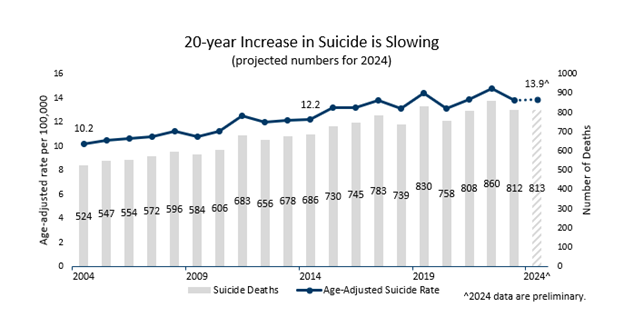News Release
May 13, 2025
Preventable deaths by suicide steady in 2024
Suicide is preventable, recovery is possible and people can seek help by calling or texting 988
The suicide rate in Minnesota remained the same in 2024, compared to 2023, with 813 suicides among residents, according to preliminary data. This marks two years of suicides below the state high set in 2022.
The rate, based on death certificates filed in Minnesota for the state’s residents, was 13.9 per 100,000 people in 2024. This rate and number of deaths is approximately the same as 2023. The data brief is available at the MDH suicide data and reports webpage, and being preliminary, the 2024 stats are subject to change when finalized.
Deaths by suicide in Minnesota have been trending up for the past 20 years with some slight fluctuations each year, mirroring patterns across the United States.
“The overall increase in deaths by suicide over the last couple of decades continues to be concerning,” said Minnesota Commissioner of Health Dr. Brooke Cunningham. “Every death by suicide is a tragedy and can have an ongoing impact on families and communities. Our aim is to help make sure people know suicide is preventable and recovery is possible.”

The 2024 data also showed an ongoing trend that rural areas in Minnesota have higher suicide rates, on average, than areas that are more urban.
Here are some key data points regarding this health inequity affecting Greater Minnesota.
- In 2024, the suicide rate in entirely rural counties was twice that of the Twin Cities metro counties.
- Entirely rural counties made up about 1.6% of the Minnesota population and 2.8% of all suicide deaths in 2024.
- Counties in the Twin Cities metro area made up about 55.1% of the Minnesota population and about 46.7% of all suicide deaths in 2024.
- This is not a new phenomenon. In the most recent five years of final data (2019-2023), the most rural counties in Minnesota had a suicide rate of 19.5 per 100,000, which is 59% higher than the Twin Cities (12.3) and 46% higher than counties with urban areas outside the Twin Cities.
Some of the contributing factors putting Greater Minnesota residents more at risk for suicide could include higher rates of firearm ownership, less access to health and mental health care, and higher poverty rates than urban areas. In a separate report confirming the trend MDH researchers are seeing, the Center for Rural Behavioral Health and Minnesota State University, Mankato, recently looked into the rural-urban suicide health inequity in the report, The Suicide Epidemic in Rural Minnesota: How we got here and how we move forward.
Minnesota’s suicide prevention efforts are based on the evidence that suicides are preventable, mental illness is treatable and recovery is possible. Rural prevention efforts include collaborating with the Minnesota Department of Agriculture (MDA) to provide training opportunities for mental health and suicide prevention in rural Minnesota farm and ranch communities.
In addition, MDH has a pilot project where young adults ages 18-24 share information about 988 with their peers. There were three participating grantees. Restoration for All (metro based), Cook County Public Health and Clay County Public Health. MDH also promotes and provides Counseling on Access to Lethal Means (CALM) training to achieve safe storage and reduce access to lethal means, such as firearms, among people at a higher risk of suicide.
Minnesota has also invested in providing local Minnesota lifeline workforce to answer 988 calls. This has resulted in high answer rates and short wait times. Preliminary 2024 data shows that 988 Minnesota Lifeline Centers answered 90,080 contacts, a 75% increase from 2023, according to the 988 data website.
“We must continue our work to support our local staffing of 988 and promote it as a lifeline, so that every Minnesotan knows that hope and help are out there,” said Commissioner Cunningham.
As has been the case for several decades, more males died by suicide in 2024 than females, with males comprising almost 80% of suicides. The male suicide rate was 21.6 per 100,000, whereas the female rate was 6.4 per 100,000. However, the rate among females in 2024 was higher than in 2023. Rates for other sexes or gender identities are not available because this information is not included on death certificates.
Firearm injuries made up the majority (51%) of suicide deaths in 2024. While firearms have been the leading injury mechanism in suicide deaths for decades, this percentage is higher than in recent years.
The Minnesota Department of Health (MDH) 2023-2027 Minnesota State Suicide Prevention Plan calls for a comprehensive approach including improving infrastructure, increasing collaboration and building capacity for local communities to implement strategies in prevention, early intervention, crisis intervention and support after a death by suicide. The plan supports suicide prevention efforts such as the 988 Lifeline System and Services, suicide prevention trainings in communities and the Zero Suicide initiative, which is a framework to improve the suicide and self-harm care within health care and behavioral health clinics and organizations.
State officials are closely watching initial proposed federal funding cuts that could significantly undermine this work to protect Minnesotans. Specifically, it calls for the elimination of both the National Center for Injury Prevention and Control at CDC and key SAMHSA Mental Health Programs, as well as possible cuts to some 988 funding.
If you need immediate emotional or mental health support, or are worried about someone else, please call or text 988 or visit the 988 Suicide & Crisis Lifeline - Call. Text. Chat. (988lifeline.org) to connect online with a trained specialist.
-MDH-
Media inquiries:
Scott Smith
MDH Communications
651-503-1440
scott.smith@state.mn.us